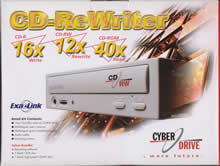CyberDrive CW038D CD-RW
1. Introduction
Review Pages
CyberDrive CW038D IDE CDR-W - Page 1
- Introduction:
 was
established in Taipei back in 1994. Since then the company has grown to become
one of the leading Taiwanese CD-ROM drive manufacturers. The main weapon of
Taiwanese manufacturers has always been a good performance that comes at a low
price. With the introduction of CW038D Cyberdrive has brought up something unique
in the recording industry. The first recorder with 12x re-writing speed! Despite
the fact that there isn't any specification standard for such an increased re-writing
speed, CyberDrive's engineers dared to take on the challenge, and currently
this recorder is the fastest re-writer around. How can this new proposal handle
some already established recorders from Plextor, LiteOn and Teac? Can the increased
12x re-writing speed be the only reason why you should buy this drive?
was
established in Taipei back in 1994. Since then the company has grown to become
one of the leading Taiwanese CD-ROM drive manufacturers. The main weapon of
Taiwanese manufacturers has always been a good performance that comes at a low
price. With the introduction of CW038D Cyberdrive has brought up something unique
in the recording industry. The first recorder with 12x re-writing speed! Despite
the fact that there isn't any specification standard for such an increased re-writing
speed, CyberDrive's engineers dared to take on the challenge, and currently
this recorder is the fastest re-writer around. How can this new proposal handle
some already established recorders from Plextor, LiteOn and Teac? Can the increased
12x re-writing speed be the only reason why you should buy this drive?
- Features:
The drive supports 16x writing speed -max- with "ExacLink" as the
main anti-buffer underrun technology. The exact writing speeds are 4x, 8x, 12x
(CLV), 16x (Z-CLV?) and re-writing speeds at 2x, 4x and 12x (CLV). The drive
has a buffer of 2MB, supports all available writing modes (TAO, DAO, Multisession
and Packet Writing) and RAW writing.
- Technologies:
 ExacLink
is a technology developed by OAK Technologies and has been used by Yamaha, LG,
Mitsumi and CyberDrive as an anti-buffer underrun solution. OAK describes ExacLink
as: "....allows high speed, high quality writing of discs on the first
try, regardless of the computer performance and drive buffer size. Buffer under-runs
are no longer a problem with ExacLink since the drive automatically responds
to the condition and continues writing as soon as more data is available without
causing a buffer under-run error...."
ExacLink
is a technology developed by OAK Technologies and has been used by Yamaha, LG,
Mitsumi and CyberDrive as an anti-buffer underrun solution. OAK describes ExacLink
as: "....allows high speed, high quality writing of discs on the first
try, regardless of the computer performance and drive buffer size. Buffer under-runs
are no longer a problem with ExacLink since the drive automatically responds
to the condition and continues writing as soon as more data is available without
causing a buffer under-run error...."
The drive also utilises a quality media detection system, which automatically lowers the maximum recording speed, according to the media condition. The same system can also be found on the Mitsumi CR-4808TE, which also uses ExacLink, and that leads us to the conclusion that both these drives use the same ExacLink ICs chipsets.
- The package:
 The
package in which the drive arrived was the retail European version. This included:
The drive itself, a multilingual manual, 1 piece (16x certified) of CyberDrive
74min CD-R blank (real manufacturer CMC Magnetics), 1 piece of CyberDrive 74min
HS-RW Blank (real manufacturer CMC Magnetics), audio cable and mounting screws.
The software supplied with the drive was Nero Burning ROM v5.5.3.1 OEM and Ahead
InCD v2.2.6 (for packet writing use). The package will be available in the retail
stores at 132 EURO (plus the VAT valid in the corresponding country).
The
package in which the drive arrived was the retail European version. This included:
The drive itself, a multilingual manual, 1 piece (16x certified) of CyberDrive
74min CD-R blank (real manufacturer CMC Magnetics), 1 piece of CyberDrive 74min
HS-RW Blank (real manufacturer CMC Magnetics), audio cable and mounting screws.
The software supplied with the drive was Nero Burning ROM v5.5.3.1 OEM and Ahead
InCD v2.2.6 (for packet writing use). The package will be available in the retail
stores at 132 EURO (plus the VAT valid in the corresponding country).
The front of the drive doesn't have the CybeDrive logo, and illustrates the exact features of the drive "16x/12x/40x" - no HS-RW logo is present. You will also find only one led, the eject/stop/play/next buttons and the headphone input jack/volume selector:

At the back of the drive we will find the usual connectors (IDE interface, power), the jumpers for setting the drive as a Master/Slave, the SPDIF output connector and the analog/digital output connectors:

- Installation:
 The
CyberDrive CW038D was installed as a Master in the secondary IDE BUS. The drive
worked in UDMA33 mode and after rebooting, it identified itself as the "CW038D
ATAPI CD-R/RW". We unchecked the Auto Insert notification, checked
DMA and rebooted.
The
CyberDrive CW038D was installed as a Master in the secondary IDE BUS. The drive
worked in UDMA33 mode and after rebooting, it identified itself as the "CW038D
ATAPI CD-R/RW". We unchecked the Auto Insert notification, checked
DMA and rebooted.
The drive was a July 2001 model with firmware revision v0.97c installed. After the shipment of the drive a newer firmware update (1.00C) was made available to all users, which improved the writing performance mostly with HS-RW media. We used Nero Burning ROM (5.5.4.0), Ahead InCD (2.26), CloneCD (3.0.8.2) and Padus DJ (3.50.799) for the recording tests.
- Test Machine:
 WinMe
OS
WinMe
OS
Soyo 7VCA
Celeron II 566 over clocked to 850 MHz
128MB SDRAM PC 133
WD 18GB UDMA 66
Quantum Fireball EX 6.4 GB UDMA 33
DAWI 2975 - PCI (ULTRA) SCSI Host Adapter
ATI AIW 128
CyberDrive CW038D firmware v1.00c
PleXWriter PX-W1610A firmware v1.03
TEAC CD-516EB firmware v1.0A
LiteOn LTR-16101B firmware vTS0N
Review Pages













